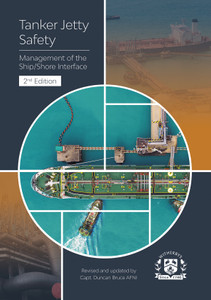
This publication provides guidance relating to oil, chemical and dual classed oil/chemical tanker manifolds with the aim of improving compatibility with shore facilities. It will benefit personnel who work with oil and chemical tanker manifolds and associated equipment or who are engaged in designing, constructing or repairing ships.
This joint publication by the Oil Companies International Marine Forum (OCIMF) and the Chemical Distribution Institute (CDI) provides clear recommendations and guidance for oil tankers, chemical tankers and dual classed oil/chemical tankers with the aim of achieving improved safety, standardisation and compatibility with terminal facilities.
It provides a significant amount of new tanker industry accepted recommendations on safety and equipment, including additional tonnage categories and recommendations for ship owners.
Areas covered include manifold position and design, working platform and spill containment, hose support, bunker connections, lifting equipment, deck fittings to facilitate hose handling at buoy moorings and connectors for ship/shore emergency shutdown equipment.
The Oil Companies International Marine Forum (OCIMF) first published Standards for Oil Tanker Manifolds and Associated Equipment in 1971. The guidance was subsequently revised in a second edition, published in 1975, primarily to take account of changes in practice reflecting the increased usage of hard arms, the introduction of large diameter floating hoses at some Single Point Moorings (SPMs) and the increased frequency of lightering operations. Further revisions in 1981 and 1991 contained expanded recommendations on lifting equipment and vapour manifolds respectively as well as a new title Recommendations for Oil Tanker Manifolds and Associated Equipment.
This new publication, the first edition of Recommendations for Oil and Chemical Tanker Manifolds and Associated Equipment supersedes the earlier titles. It takes account of the many years of industry experience with the previous guidance and builds on the earlier recommendations.
Section one – Manifold position
1.1 Centre of manifold
1.2 Distance from the ship’s side
1.3 Height of manifold
1.4 Spacing
1.5 Cargo vapour manifolds
Section two – Working platform and spill containment
2.1 Size and position
2.2 Spill containment draining
2.3 Strength of working platform
2.4 Loading arm jacks
2.5 Design of working platform
2.6 Access to working platform
2.7 Elevated working platforms
Section three – Manifold design
3.1 Carbon steel manifold
3.2 Stainless steel manifold
3.3 Assumptions for load calculations
Section four – Cargo and vapour manifold specification and fittings
4.1 Valves
4.2 Valve actuators
4.3 Distance pieces
4.4 Spool pieces and reducers
4.5 Blank flanges
Section five – Hose support at ship’s side
5.1 Curved plate or pipe hose support
5.2 Hose support position
5.3 Hose support strength
Section six – Bunker connections and other connections
6.1 Number of connections
6.2 Size of connections and reducers for oil bunkers
6.3 Size of connections and reducers for LNG bunkers
6.4 Strength
6.5 Location
6.6 Oil spill containment
6.7 LNG spill containment and protection
6.8 Other connections
Section seven – Lighting
Section eight – Lifting equipment
8.1 Safe working loads
8.2 Area of operation of lifting equipment
8.3 Operating criteria for lifting equipment
8.4 Personnel transfer by crane (man-riding)
Section
nine
–
Deck
fittings
to
facilitate
hose
handling
at
buoy
moorings
9.1
Cruciform
bollards
9.2 Bitts
9.3 Fairleads
9.4 Deck rings or lugs
9.5 Arrangements for ship to ship transfer
Section ten – Connectors for ship/shore emergency shutdown system
Section eleven – Standard manifold arrangements
11.1 Category ‘A, B, C’ Standard manifold arrangement, including vapour lines, for vessels up to 25,000 sdwt
11.2 Category ‘D’ Standard manifold arrangement, including vapour lines, for 25,001 to 60,000 sdwt vessels
11.3 Category ‘E & F’ Standard manifold arrangement, including vapour lines, for 60,001 to 160,000 sdwt vessels
11.4 Category ‘G’ Standard manifold arrangement, including vapour lines, for vessels over 160,000 sdwt
11.5 Typical manifold arrangement for a tiered chemical tanker
OCIMF
The Oil Companies International Marine Forum (OCIMF) is a voluntary association of oil companies with an interest in the shipment and terminalling of crude oil, oil products, petrochemicals and gas. OCIMF focuses exclusively on preventing harm to people and the environment by promoting best practice in the design, construction and operation of tankers, barges and offshore vessels and their interfaces with terminals. Learn more at www.ocimf.org
CDI
The CDI is a chemical industry organisation, incorporated under the law of the Netherlands as the Stichting Chemical Distribution Institute (CDI) and operates as a non-profit making foundation.
CDI is managed by a Board of Directors consisting of seven individuals nominated by the participating chemical companies. The Board of Directors establishes policy and is responsible for overall affairs of the foundation. Individual Executive Boards are elected to oversee and direct the staff managing day to day activities for the Marine, Terminals and Marine Packed Cargo Schemes.
- Number of Pages:
- 66
- ISBN:
- 9781856097413
- Published Date:
- September 2017
- Binding Format:
- Hardback
- Book Height:
- 302 mm
- Book Width:
- 216 mm
- Weight:
- 0.8 kg
- Author:
Oil Companies International Marine Forum
- Preview:
- Yes





